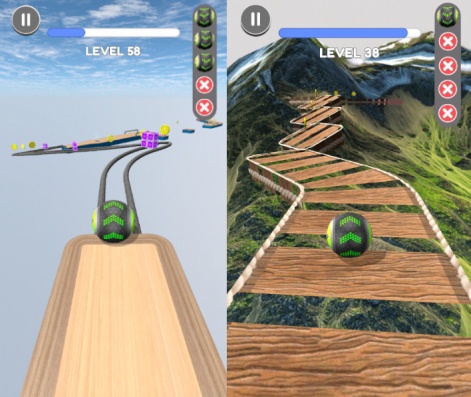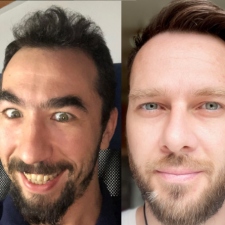Going Balls launched over two years ago and still finds itself frequenting the top ten charts. According to data.ai in November 2023, the game was the second most downloaded hypercausal game and the 19th most downloaded game from all genres. In a time where some still say the hypercausal model is dying, Going Balls has managed to remain strong and continues to captivate its audience.
We spoke with Stefan Filote and Ionut Iftimia from Pronetis and the developers of Going Balls on the initial creation and inspiration behind the game and what went into developing the title. We also discuss how the team has been able to keep the game successful for the last two and a half years.

Pocketgamer.biz: What's the story behind Going Balls? Was there a game or a specific genre type that you were looking to take inspiration from when you came up with the idea?
Making a successful game in this genre is not just about building and releasing them; it’s about creating an evolving experience.Stefan Filote and Ionut Iftimia
Stefan Filote and Ionut Iftimia: The story began with Gyrosphere Trials, one of our previous games aimed at a mid-core audience that had performed well in the past and showed great retention but was beginning to lose steam. Its niche graphics and the tough challenges in the game gave it a strong appeal to a particular audience, but that also limited its reach. Encouraged by its success, we attempted a sequel aimed at a core audience, however the game failed to gain momentum. It was time for a whole new ball game whose gameplay would appeal to a mass audience. There began our journey into hypercasual games.
In the following couple of years, while working on hypercasual games, we realised that making a successful game in this genre is not just about building and releasing them; it’s about creating an evolving experience that resonates with a wider audience. This process doesn't stop after the game is released.
With that in mind, we decided to give our old game, Gyrosphere Trials, a radical makeover. We knew the core loop from Trials had potential, but the game was too hard. So, we took a different approach to how we created the levels, making them more accessible, fun and visually exciting for a wider range of people of all ages and skill levels. For the next six months, we worked on acquiring new users, testing and fine-tuning the game until we were happy with the results.
What do you think makes a good hyper-casual game, and do you believe that hyper-casual is growing less popular, or is it a genre that can last forever?
Hypercasual games are captivating and straightforward, designed with gameplay that’s easy to understand and can be played by anyone. Their quick development cycle and the ability to swiftly test a game with real users make them an ideal game genre for small teams like ours. This approach eliminates the risk of investing months or years in product development without concept validation. However, the very elements that make hyper-casual games accessible – simplicity and ease of learning - can also limit their longevity.
That’s why our approach to game development blends hypercasual concepts with midcore game mechanics and depth. We view the game's launch as just the beginning - it’s the validation of the concept. From there, guided by user feedback and user data, we continuously iterate and add content throughout the game's lifespan. This allows us to maintain player engagement, foster a lasting connection with our audience, and publish a game that will remain in the charts for the long term.
It’s all about keeping players engaged and coming back for more.Stefan Filote and Ionut Iftimia
What do you feel you have done to keep Going Balls staying up there in the top 10s? Do you have any tips for other games looking to match your success?
We’re on a never-ending cycle of developing and testing new mechanics and content, which either get to remain in the game, transform into something else, or get cut out. It’s all about keeping players engaged and coming back for more. These additions include tournaments, game modes, and, of course, more levels. With each update, we try to introduce fresh challenges, strategies, and reasons for players to keep exploring the game’s world.
We advise trying as many new things as fast as possible and keeping an eye on player data. Most importantly, choose great partners who see things the same way you do and, if possible, even clearer. We couldn’t have gone this far without the great team at Supersonic from Unity, who not only encouraged our experimental design approach but also helped us refine it with thorough A/B tests and, as always, backed it up with in-depth data.
What advantages/assets does using Unity for a game's development give it?
Firstly, there are the obvious advantages like ease of use of the Unity engine, the strong and helpful developer community, the performance optimisation for mobile, and many more factors that ease the daily friction of game development and allow us to maintain a quick pace. We would never get around to building games if we had to manage all those things.
There are endless possibilities for game ideas, and we are always pitching concepts to one another.Stefan Filote and Ionut Iftimia
Then there’s the asset store, which is a treasure trove of tools and content. We use it for quickly prototyping and testing new concepts within the game, and only once they are approved by the players (by checking the player data) do we create the final version of the content.
For example, we're currently adding skull levels, which are challenging optional levels accessible from the main game progression. Initial testing showed this to be attractive to some players while others dropped out. While testing how to reduce players dropping out from frustration, we used the Unity asset store to quickly build gates designed to limit the number of attempts by a player. Only once we have a winner will we invest time in custom content.
What plans do you have for Going Balls’ ongoing success?
We have lots of exciting improvements and additions planned. We are working on new missions, more game modes and more of the one thing players are always asking for more and more levels!
Is there anything coming up from you guys in the future that we should watch out for?
There are endless possibilities for game ideas, and we are always pitching concepts to one another. But for now, we’re pouring all of our efforts into Going Balls. We still want to do a lot with the game and aim to keep the balls rolling!





















